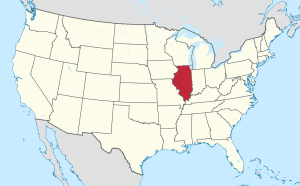Plattville, Illinois facts for kids
Quick facts for kids
Plattville, Illinois
|
|
|---|---|

Location of Plattville in Kendall County, Illinois.
|
|

Location of Illinois in the United States
|
|
| Country | United States |
| State | Illinois |
| County | Kendall |
| Township | Lisbon |
| Area | |
| • Total | 2.26 sq mi (5.85 km2) |
| • Land | 2.26 sq mi (5.85 km2) |
| • Water | 0.00 sq mi (0.00 km2) |
| Elevation | 600 ft (200 m) |
| Population
(2020)
|
|
| • Total | 220 |
| • Density | 97.39/sq mi (37.60/km2) |
| Time zone | UTC-6 (CST) |
| • Summer (DST) | UTC-5 (CDT) |
| ZIP code |
60560
|
| Area codes | 630 / 331/815 |
| FIPS code | 17-60391 |
| GNIS feature ID | 2399688 |
Plattville is a small village located in Kendall County, Illinois, in the United States. It is found west of Joliet. As of the 2020 census, about 220 people live there.
The community of Plattville started in 1860. It was named after Daniel Platt, who built the first home there in 1834. His home was on an old stagecoach route between Chicago and Ottawa.
Plattville officially became a village in March 2006. This means it gained its own local government. George "Jerry" Friel was the first mayor of Plattville. A mayor is the leader of a town or city's government. He worked hard to help the village become official.
Where is Plattville Located?
Plattville is in the southern part of Kendall County. It is about 17 miles (27 km) west of Joliet. The village is also part of the larger Chicago metropolitan area. This means it is near the big city of Chicago.
To the north of Plattville, you will find Yorkville. To the southwest, there is the town of Lisbon. The village covers a total area of about 2.26 square miles (5.85 square kilometers). All of this area is land.
Who Lives in Plattville?
The people who live in Plattville make up its population. According to the 2020 census, there are 220 residents. The population density is about 97 people per square mile. This means it is a quiet, less crowded place to live.
| Historical population | |||
|---|---|---|---|
| Census | Pop. | %± | |
| 2010 | 242 | — | |
| 2020 | 220 | −9.1% | |
| U.S. Decennial Census | |||
See also
 In Spanish: Plattville (Illinois) para niños
In Spanish: Plattville (Illinois) para niños 

